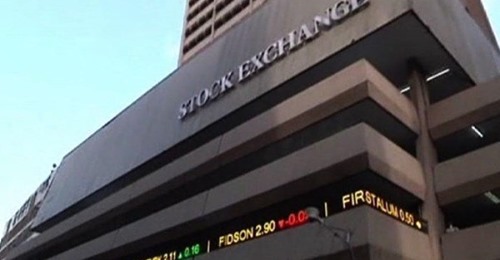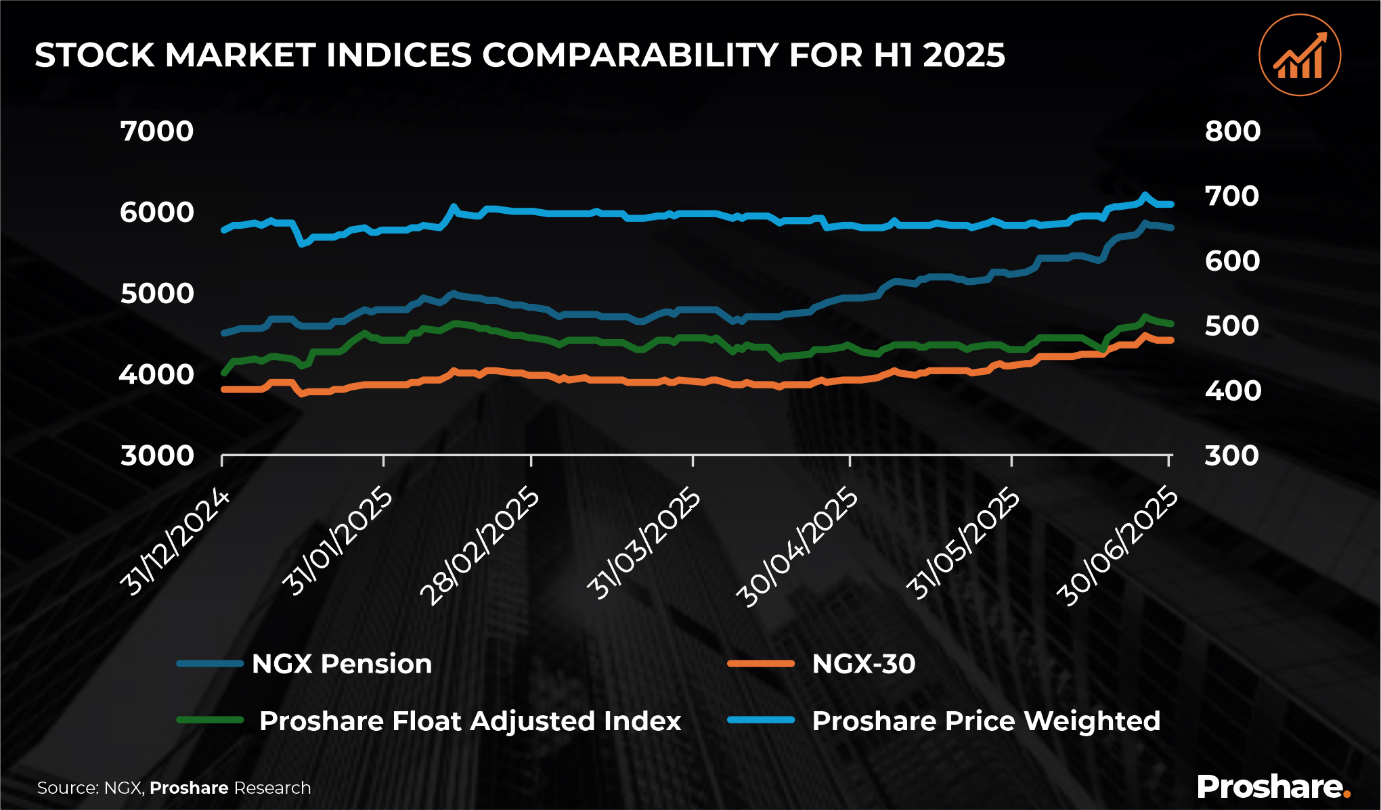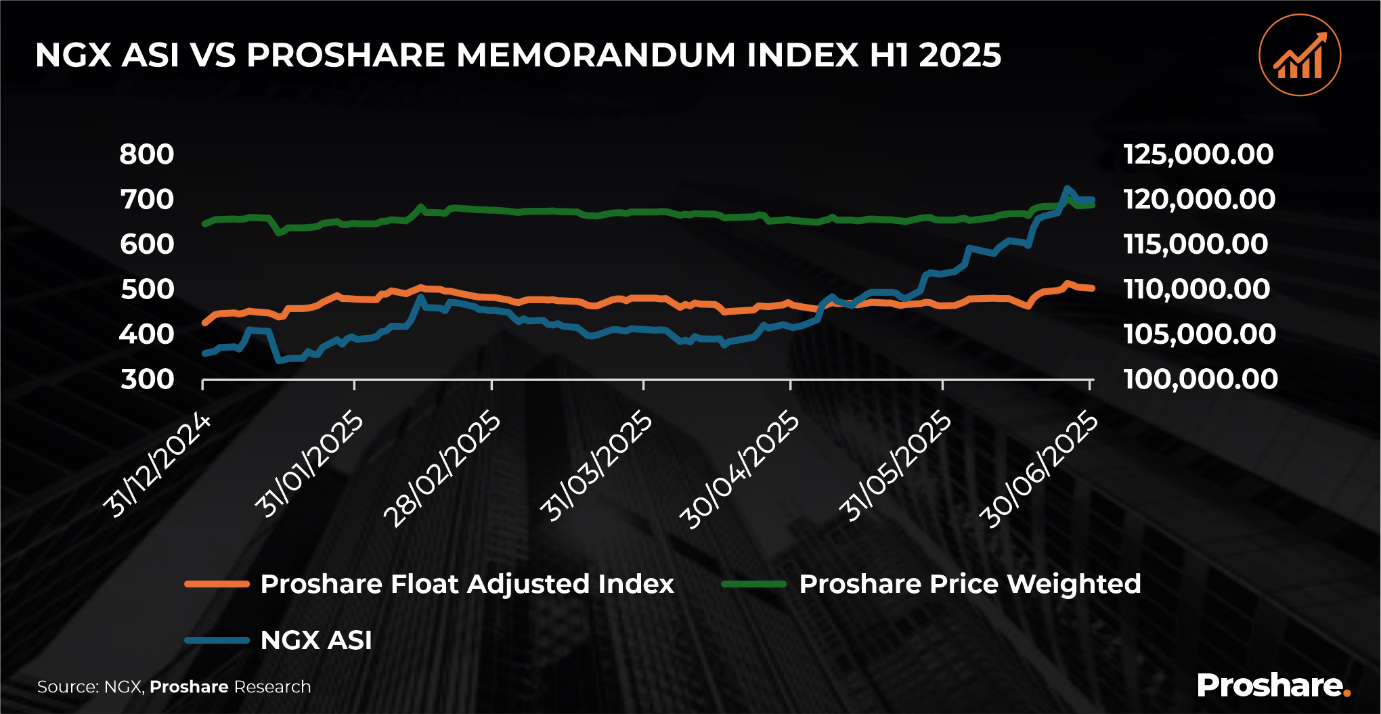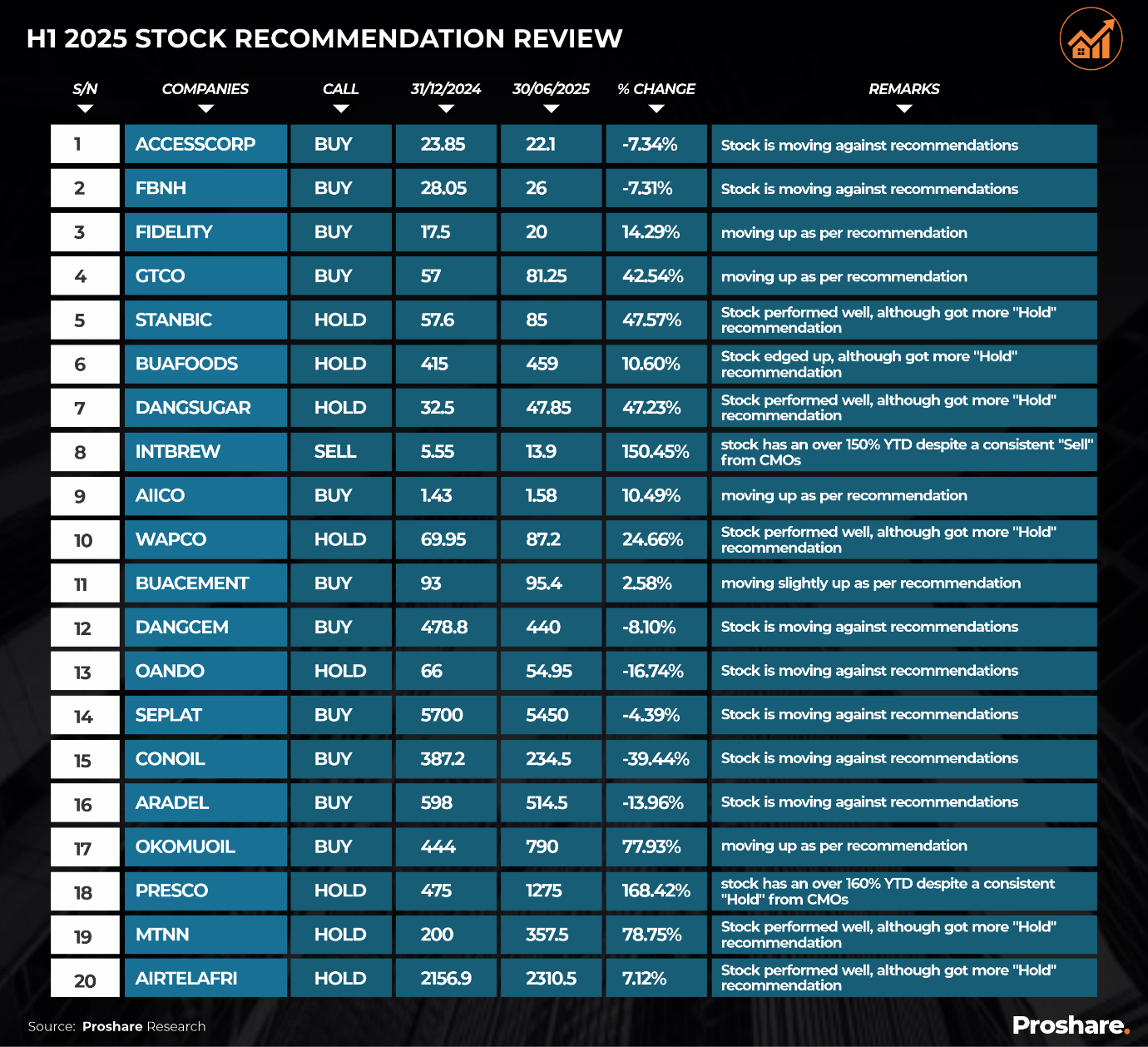H1 2025 Stock Recommendation Review – The Art of Getting it Right

“It’s tough to make predictions, especially about the future.” – Yogi Berra
The year 2025 has so far been a unique year for investors, as major global and national political and economic events have made money and capital markets move with the ease of a grandfather rocking chair. The uncertainty has wrong-footed analysts’ outlook and makes stock picks more difficult. Despite the economic challenges, Nigeria’s capital market operators did well in the first half (H1) of 2025, with a few stock picking recommendations biting the dust, while others have proved to be smart market plays.
Investment
The review observes that recommendations have been made for different reasons that emerge from the following considerations:
- Upside opportunities as a result of potential market bullishness or upward price adjustments
- Downside opportunities that result from cost averaging to bring down the average portfolio costs that ride on temporary price dips
- Portfolio performance improvement by rebalancing equities to take advantage of market bullish and bearish swings
- Long-term versus short-term market plays
Regarding Index positioning, The Nigerian Exchange All Share Index (NGXASI) delivered a strong performance in the first half of 2025, closing at 119,978.57 points, with a year-to-date (YTD) gain of 16.57% from 102,926.40 points recorded on December 31, 2024. The market started Q1 on a positive note, recording cumulative growth of 2.66%. The Nigerian equity market closed the first half of 2025 with mixed sectoral performances, driven by macroeconomic policy adjustments, sector-specific news, and investor sentiment.
Equally interesting is that over the H1 horizon, Proshare’s price-weighted market capitalisation Index and float-adjusted market capitalisation Index outperformed both the NGX ASI and the NGX 30 Indices (see Charts 1 & 2 below).
Chart 1

Chart 2

In the first half (H1) of 2025, analysts reviewed stock recommendations from Capital Market Operators (CMOs) for comparability. In the banking sector, ACCESSCORP, FIRSTHOLDCO, and FCMB have received an increasing number of “Buy” recommendations from CMOs. However, their stock prices fell by 7.34%, 7.31%, and 1.60% in H1 of the year. FIDELITY and GTCO received positive recommendations from CMOs, with their stocks rising by 14.29% and 42.54%. However, STANBIC, which received “Hold” recommendations, showcased impressive resilience with a year-to-date (YTD)) rise of 47.54% as of June 30, 2025. These results indicate that most CMOs were not entirely accurate in their recommendations, although other factors, such as the CBN forbearance loan, also impacted companies listed in the banking sector (it should be noted that a hold position in a rising market or equity enhances investors’ yields).
Investment
The Consumer Goods Sector saw mixed recommendations for several companies. BUAFOODS, DANGSUGAR, NB, and NASCON received predominantly “Hold” recommendations from CMOs, indicating a cautious but steady outlook for these companies in the equity market. Despite this conservative stance, these firms demonstrated remarkable year-to-date (YTD) growth with BUAFOODS increasing by 10.60%, DANGSUGAR by 47.23%, NB by 84.38%, and NASCON showing an impressive 126.48% rise. INTBREW faced a different narrative. It gathered more “Sell” recommendations, suggesting analysts’ concerns over its stock’s sustainability; however, it achieved a remarkable YTD increase of 150.45%. Overall, the Consumer Goods Sector has emerged as a clear leader in the equities market, boasting an impressive average growth rate of 52.21% in H1 2025. This significant performance was supported by strong earnings reports in the first quarter (Q1 2025) and an overall positive investor sentiment toward Fast-Moving Consumer Goods (FMCG) companies.
In the Insurance Sector, AIICO received a strong round of “Buy” recommendations in the first half of the year, reflecting growing investor confidence. As of June 30, 2025, it recorded a year-to-date (YTD) growth of 10.4%. In contrast, INTENEGINS has encountered more “Sell” recommendations but still posted a modest YTD increase of 0.59%. This contrast highlights the differing investor sentiments and market conditions that affect these two companies.
In the Industrial sector, WAPCO received more “Hold” recommendations in H1 2025 but saw a notable 24.66% (YTD) growth, reflecting strong resilience. BUACEMENT and DANGCEM also received more “Buy” recommendations with a modest YTD increase of 2.58%, while DANGCEM faced challenges, resulting in a decline of 8.10% YTD.
In the Oil and Gas Sector, analysts predominantly recommended “Hold” ratings for OANDO and JAPAULGOLD. OANDO declined by 16.74%, while JAPAULGOLD experienced a robust gain of 10.24%. SEPLAT, CONOIL, and TOTAL received more “Buy” recommendations. Despite this positive outlook, SEPLAT and CONOIL faced declines of 4.39% and a significant 39.44%. TOTAL managed a modest gain of 1.00% which overall reflects the sector’s volatility and varying investor sentiments.
In the Agriculture sector, OKOMUOIL and PRESCO achieved 77.93% and an impressive 168.42% YTD growth. The two companies received more “BUY” recommendations, which perfectly aligns with CMOs’ recommendations for indicating strong investor confidence.
In the ICT sector, MTNN, AIRTELAFRI, and CHAMS received multiple “Hold” recommendations from CMOs in the first half of the year. Despite these conservative assessments, the financial performance of these stocks has been impressive. Specifically, MTNN has achieved a remarkable (YTD) growth of 78.75%, reflecting strong market demand and investor confidence. AIRTELAFRI recorded a modest growth of 7.12%, while CHAMS experienced a YTD growth of 18.09%. These figures indicate that, despite the cautious outlook suggested by CMOs, investor sentiment and market conditions have contributed to a robust performance in the ICT sector.
Analysts believe it is too early to conclude that recommendations from Capital Market Operators (CMOs) do not significantly reflect market performance. However, the recommendations issued in the first half of the year have shaped the market and provided valuable guidance for investors in managing their portfolios.
Investment
Mid-quarter factors influenced market dynamics, leading to instances where some CMOs made accurate calls, while others appeared misaligned with investor/market sentiment. Proshare analysts note that CMO recommendations may be based on unique portfolio assessments for specific types of investors. For example, investors with pre-existing high average costs of equity acquisition may be advised to buy equity price dips to average down their cost of portfolio acquisition. This may appear to be a misalignment without understanding the portfolio plan of the CMO after a review of clients’ effective portfolio yields (see Table below).
Table 1:

Investment




